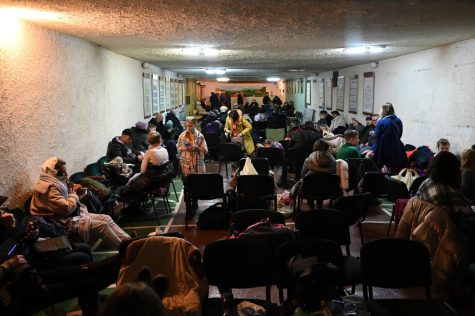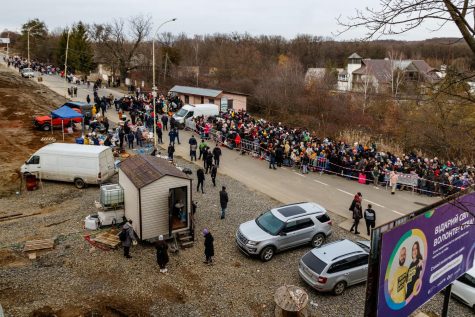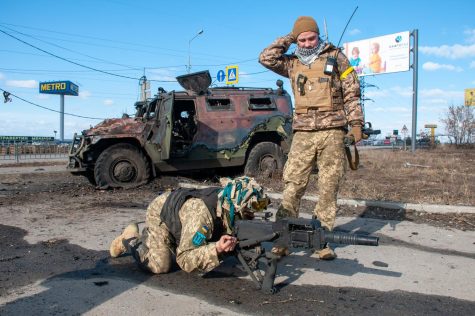One year into the Russia-Ukraine War, history is everything
Fair Use Image: Fotoreserg via Deposit Photos
TENSIONS RISE. On Mar. 26, a Ukrainian soldier stands at the ready at a checkpoint near Kharkiv. A little over a year after the start of the Russia-Ukraine War, the conflict remains in full swing.
On Feb. 24 of last year, Putin announced that he would be launching a “special military operation” in Ukraine. This statement followed up a proclamation of his recognition of two Russian separatist zones in eastern Ukraine three days prior, and the Russian annexation of the Ukrainian region of Crimea in 2014. Mere minutes after Putin’s announcement, Russian air strikes and ground forces were released towards Ukraine’s northeastern front, beginning one of the most defining wars of the decade.
At the heart of the conflict is a complex history. Russia and Ukraine were both constituent republics of the USSR, which has significantly shaped the discourse within each country. Upper school English teacher Dr. Jessica Gokhberg, whose family is from Ukraine, said that two key points are intertwined with the conflict: NATO (the North Atlantic Treaty Organization) and the Ukrainian genocide.
NATO was founded with the objective of protecting the North Atlantic states from threats to democracy — which primarily meant communism. “Among the assurances [USSR General Secretary Mikhail Gorbachev] received. . . was ‘the transformation of NATO to lead to a more inclusive and integrated European space, that the post-Cold War settlement would take account of the Soviet security interests’,” said Gokhberg.
Relations between Russia and NATO were not initially antagonistic when first established in 1991 within the North Atlantic Cooperation Council. In 1994, Russia joined the Partnership for Peace program; in 2002, the NATO-Russia Council (NRC) was founded to manage joint security projects. However, NATO-Russia relations began to strain as a result of Russia’s hostility to neighboring states and conflicts involving Russia and Ukraine in the 2000s. In response to the Russian annexation of Crimea, NATO suspended cooperation with Russia, and as a result of the invasion of Ukraine, relations have reached a low not seen since the Cold War.
NATO relations have been very different with Ukraine. Since 2008, Ukrainian leaders have expressed the desire to join NATO, and Zelensky has been a strong advocate for the partnership from when he took office in 2019. A law passed in 2010, however, conformed the country’s nonaligned status and effectively forbids Ukraine from joining any military bloc, and in order for Ukraine to join NATO, every country in the alliance would have to be in unanimous support for the adjoining, both of which make NATO access very difficult for Ukraine. However, Putin continues to amplify his complaints against NATO aggression and Ukraine’s bid to join, using them to express anti-West sentiments and justify the invasion of Ukraine. His comments are in spite of historical precedence and his own reaction to NATO bids from Nordic countries, which proves that the justification of preventing NATO expansion — especially into Ukraine — he presents is not reflective of the situation’s reality.

According to Gokhberg, Putin’s second primary justification for conflict is ‘denazifying’ Ukraine, a contradictory term given Ukraine’s Jewish history and one which Putin has misconstrued and used as propaganda. “If you want to talk about this war you must talk about Zelensky’s Jewishness and the historic Jewishness of the occupied land,” they said.
The history of Jews in Ukraine dates back more than a thousand years; at one time it home to the largest population of Jews in the world. Gohkberg noted that President Zelensky was born and raised in Kryvyi Rih, a primarily Jewish city in central-eastern Ukraine, and that several Russian-occupied territories have been historically Jewish, making Putin’s proclaimed ‘denazification’ definitively ironic. In Zelensky’s final plea for peace on the eve of the war, he asked, “How can I be a Nazi?”
“Jews were forced to settle in and around the Black Sea again in the 20th century because of Stalin’s 1932 manufactured famine in Ukraine, Bandera’s extermination of 1.5 million Ukrainian Jews, Hitler’s deportation of 2.2 million Jews, the war’s overall displacement of 10 million Ukrainians by 1945, Stalin’s 1944 ethnic cleansing of Crimean Tatars, and his 1949 purge of Jews in his ‘denazifying’ campaign—all of which left a mere 100,000 Jews in Ukraine,” Gokhberg said, illustrating the widespread persecution.
Gokhberg’s connection to the Russian persecution of Jews is deeply personal. One of the Russian army’s earliest targets in the war was the Babyn Yar memorial in Kyiv. The memorial commemorates the Babi Yar shootings of 1941 and serves to sustain memory of the Holocaust. The memorial covers a mass grave where an estimated 70,000-100,000 Jewish corpses lay.
“Whatever family I had is there,” they said. “What’s left is the small unit that was able to flee Soviet Ukraine in 1989.”
It’s from a legacy of genocide and tenuous alliances that the war sprouts — and its justifications, however absurd they may be. Because of this complicated history, the conflict remains in full swing. One year and two months into the war, here are the key events on the timeline.
Attack on Kyiv
In February, Russian forces attacked Kyiv, Ukraine’s capital, in an attempt to overthrow Zelensky’s government. Though the odds were in their favor, Ukrainian resistance forced Russian troops to pull back.
Russian Seizures in Ukraine
One of Russia’s first military objectives was to create a land bridge between Crimea, a Ukrainian region seized in 2014, and the Russian breakaway regions of Donetsk and Luhansk in eastern Ukraine. By March 19, Russia had seized almost twenty-five percent of Ukraine.
Brutality in Bucha
When Russian troops withdrew from Bucha, a city west of Kyiv, they left behind a scene of atrocity, including remains of shellings and executions. Hundreds of Ukrainian civilians were murdered, and a mass grave with over 400 bodies was discovered. When images spread, the Russian government made unsubstantiated remarks claiming the images were falsified.

Sinking of the Moskva
The Moskva, flagship of Russia’s Black Sea Fleet, was sunk by two Ukrainian missiles on April 14. Despite Russian claims of a fire on board, US intelligence confirmed that the sinking was the result of a Ukrainian attack. The naval loss is Russia’s greatest in several decades.
Mariupol Plant Defense
In May, Ukrainians who had been withstanding weeks of fighting outside the Mariupol Steel Plant surrendered to Russian forces. The battle for the plant had become a symbol of Ukrainian resistance, and the fighters were praised by officials.
Russian Partial Mobilization Begins
Following several significant defeats in Ukraine, Russia began implementing drafts by September. This led to protests and men choosing to leave the country, though it increased troop numbers.
Crimea Bridge Damage
In a blow to Russia, an explosion critically damaged part of the Kerch Strait Bridge, which links Russia and Crimea. The bridge is not only practically important but deeply symbolic to the Russian government.
Blackout in Kyiv
At the end of the fall, Russian forces began targeting Ukrainian energy infrastructure. Russia was accused of trying to deliberately freeze out Ukrainians as the seasons changed. In addition to blackouts, areas of the country were left power- and water-less.
Liberation of Kherson
Russian forces withdrew from the city of Kherson, located on the Black Sea, after eight months of occupation. The victory prompted scenes of celebration in the region.
White House Visit
On Dec. 20, President Zelensky traveled to Washington D.C. to address the U.S. Congress, where he successfully appealed for a 40 billion dollar spending plan to be used over the next decade. It was the first international trip Zelensky had made since the beginning of the war.
German Tanks Approved
After weeks of external bickering and pressure, German Chancellor Olaf Scholz announced that Germany would send several of its Leopard 2 tanks to Ukraine and allow other European countries to export the tank. The decision marked an important step forward in Western support for Ukraine.
One Year Mark
On Feb. 20, President Joe Biden arrived in Kyiv as part of a previously unannounced trip. In Kyiv, Biden met with several Ukrainian officials in addition to President Zelensky, where he reaffirmed the United States’ alliance with Ukraine and promised another 500 million dollars worth of aid.

Arrest in Russia
Russia recently detained Wall Street Journal reporter Evan Gershkovich on grounds of suspected spying. The arrest gained much international attention and criticism, from the US government and groups advocating for press freedom alike. Gershkovich was on an assignment in the rural mountain region of Ural.
So what comes next?
“What I can say is that I very much doubt the US will ever put soldiers on the ground in Ukraine,” Gokhberg said. “Russia is waging a war of attrition–meaning the Russian army is betting on creating such fundamental infrastructural damage to Ukraine that there won’t be any chance of recovery. The more infrastructural power Ukraine loses, the less invested the US will be in saving it.”
But how long can Russia realistically continue to wage war? According to Gokhberg, “as long as the world depends on fossil fuels.” Russia is the third-largest oil producer, and around 80% of the natural gas it produces goes to the EU through pipelines in Ukraine.
In the meantime, what can be provided is support. “The best humanitarian aid is sent by individuals, to individuals,” Gokhberg said. Their organization of choice is the Jewish nonprofit humanitarian organization HIAS (the Hebrew Immigrant Aid Society), the organization that brought their family to the United States. HIAS provides options to donate, send supplies, and assist refugees directly.
A few months into the first year in the war, there is no clear end in sight to the conflict for either the Ukrainians or the Russians. Putin’s objectives of total capture or destruction of Ukraine have not changed, and in Russia, anti-war speech remains outlawed. Enmity remains at a high between Russia and the US, especially considering the suspected Russian tampering with a US drone and Finland’s recent entry into NATO. Ukrainian troops continue to fight in a war built on geopolitical tensions and religious persecution.
Gokhberg’s thoughts?
“There isn’t a part of this war that doesn’t carry the historical burden of memory.”
The breakdown of NATO-Russia relationships, Ukraine’s lack of membership, and the goal of ‘denazifying’ a country relentlessly purged by antisemitism have had countless effects: defining Russian, US, NATO, and Ukrainian geopolitics, providing nationalistic justifications for an unprovoked war, and shaping the groundwork of the conflict. Major strategic and military wins for Ukraine have been instrumental in retaking land initially seized by Russia even as Russia censorship and propaganda remains widespread, and Western funding remains pivotal providing security in the constantly shifting landscape. Ultimately, history laid the foundation of the war, and as the conflict progresses, history will continue to define it.
Aarushi Bahadur (she/her) is an avid record collector. Her interest in vinyl began when she picked up a Til Tuesday record from a secondhand bookshop...
Smriti • Apr 7, 2023 at 9:07 am
This is an aptly summarized article with crucial details highlighted making the chronology easily comprehensible.
Very well written. Hope to see many more insights coming from Aarushi Bahadur.